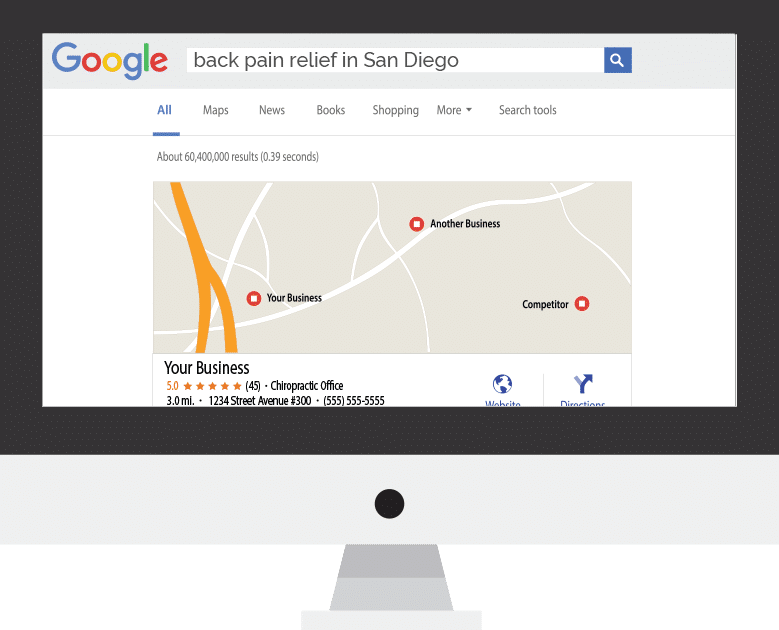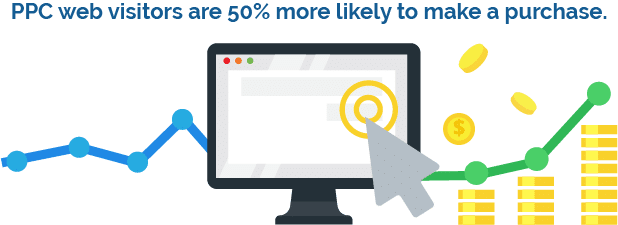Common Mistakes You Might Be Making With Your PPC Strategy
PPC, or pay-per-click advertising, is a quick and effective way to get your practice shown at the top of Google’s first page of search results. By bidding on the keywords your target audience is using to find businesses like yours, you are able to increase your website’s visibility and better the chances that interested clicks will come your way.
We’ve said it before and we’ll say it again:
The better your Google ranking, the more traffic your website will receive.
Even though a search query may populate thousands of results, 67% of clicks go to the top 5 results on a search engine results page. By investing in targeted marketing strategies like PPC, you can guarantee a top 3 spot for applicable searches.
However, simply bidding on a keyword or two won’t yield results right away. By avoiding common pitfalls beginners tend to make when developing their PPC strategy, you can experience a quicker return-on-investment and more appointments booked in your calendar.
Next, we’re going to tell you what some of those mistakes are and how you can keep from committing these faux pas at your practice.
What NOT to do With Your PPC Strategy
Sometimes, it’s as important to learn what not to do as it is to learn what you should do. Pay-per-click advertising can be a highly efficient tool as long as it is leveraged correctly. Here are four things you should definitely not do when you are creating your PPC strategy:
1. Too Many Keywords
As we mentioned earlier, PPC advertising requires marketers to bid on keywords so that they can show their advertisements to audiences making search queries related to their products or services. However, if you split your attention and budget between too many keyword phrases, you could end up wasting resources on keywords that are underperforming.
Research shows that the majority of Google Ads accounts produce the most revenue from just 12% of their keywords. This means that the remaining 88% of keywords could be costing your business more money than they’re worth!

How to Fix It…
Firstly, make sure you are not using the “broad match” option on Google Ads. This is the default match type and may seem like a good idea since it can show your ad to more people, but it can actually hurt your campaign. This selection will have you competing for keyword phrases that are loosely similar to your target keywords, which means that you are less likely to get your ads in front of your ideal audience. Instead, go for a phrase or exact match option so that you can niche down on your target demographic.
Second, review the analytics data to see which keywords are performing best. Then, eliminate those that aren’t reaping the kinds of results you want. Google Ads makes this process fairly easy and offers tons of resources to help you navigate the platform.
2. Forgoing Call Tracking
Call tracking helps marketers identify which strategies are producing the best results. Are the majority of this month’s calls coming from a recent advertisement? Or are they originating from your website?
 Many local practices use CTAs (calls-to-action) to urge potential patients to call into their office to schedule a consultation or service rather than fill out an online form. Without this call tracking, it will be harder to distinguish which ads and resources are performing best. This could cause you to invest your money into the wrong marketing channels, resulting in a loss for your business.
Many local practices use CTAs (calls-to-action) to urge potential patients to call into their office to schedule a consultation or service rather than fill out an online form. Without this call tracking, it will be harder to distinguish which ads and resources are performing best. This could cause you to invest your money into the wrong marketing channels, resulting in a loss for your business.
How to Fix It…
Implement call tracking so that you can measure the performance of your marketing collateral. This will require you to create different phone numbers or extensions for different advertisements, ad groups, campaigns, or other types of resources. It’s up to you to decide how you want to segment your call tracking, but make sure you are accurately attributing calls to each group.
Call tracking programs can help you accomplish this as well as easily create unique phone numbers for your practice. For our clients, we use Marchex to track various ad campaigns and phone calls stemming from their organic marketing efforts.
3. Not Focusing on Ad Copy
Odds are, your advertisement isn’t the only ad populating on any given search engine results page. To convince web users that your ad offers the best information, services, or products to satisfy their search, you have to stand apart from your competition.
Since most search engine ads are text-only, it’s essential that you put thought into your headlines and ad copy.
How to Fix It…
Drafting effective ad copy requires a lot of trial and error. Luckily, your ad copy doesn’t need to be static. If an ad is failing to attract the number of clicks you reasonably expected, try changing up the ad copy to see if that’s the problem.
New to writing copy for advertisements? A successful formula you can use to create a great headline and ad copy is:

In the headline, address a common pain point your target audience faces that relates to the search query your ad is populating for. Then, in the meta description, encourage web users to click on the ad to learn about how your practice can provide a solution to their problem.
You may also want to learn what other healthcare professionals are using in their ad copy to help inform your own. Find out which companies and practices are successfully using Google Ads for doctors and try to find commonalities between different ads.
4. Bidding Too Low
We know that it’s tempting to bid low on keywords, especially in the beginning phases of developing your PPC strategy. Afterall, bidding low will save you money when you’re not sure how your ad will perform, right?
Wrong.
In the end, this could actually cause you to waste more money and time on ads that aren’t receiving traffic. This is because bidding too low on keywords means that it’s less likely your new ads will populate for related searches. By bidding higher, you will better be able to determine which ads are getting the most clicks because they will be more likely to populate in SERPs.

Plus, when you have an ad that is capturing clicks, your quality score will improve. Your total CPC (cost-per-click) bid is based on your quality score, maximum bid, and the ad rank of your competitors. Therefore, a better quality score has the power to decrease the cost-per-click!
How to Fix It…
Instead of bidding low when you start a campaign, bid high. This will give you a chance to see how well other elements of your ad, such as ad copy and landing pages, are working. If you are showing up on SERPs but failing to earn those click-throughs or calls into your office, then you’ll know that there is another issue with your advertisement.
If those ads are successful, your quality score and ad rank will begin to improve. Then, you can decrease your bid as the other two components prove to Google that your ad is worth showing to web users.
Targeted Marketing Strategies for Healthcare Professionals
A well-executed PPC strategy can help you attract new patients or clients to your practice, increase web traffic to your site, and convert more of those web visitors into customers at your office. Even small-to-medium sized businesses can benefit from this marketing tool.

Not ready to tackle PPC on your own? Contact our team to learn more about our target paid advertising services, developed to appeal to local audiences in your community when they’re looking for practices in your industry.
Check out these other helpful resources…
5 of the Best PPC Tips We’ve Ever Heard
Creating an Effective PPC Landing Page
Tracking the Success of Your PPC Campaign




